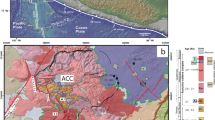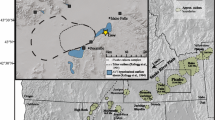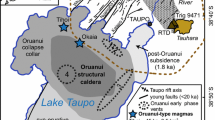Abstract
A voluminous (>600 km3) and long-lived (~520–75 ka) phase of rhyolitic eruptions followed collapse of the Yellowstone caldera 640 ka. Whether these eruptions represent a dying cycle, or the growth of a new magma chamber, remains an important question. We use new U–Th zircon ages and δ18O values determined by ion microprobe, and sanidine Pb isotope ratios determined by laser ablation, to investigate the genesis of voluminous post-caldera rhyolites. The oldest post-caldera rhyolites, erupted between ~520 and 470 ka, exhibit extreme age and oxygen isotopic heterogeneity, requiring derivation from individual parcels of low-δ18O melts. We find a progressive increase in zircon homogeneity for rhyolite eruptions from ~260 to 75 ka, with homogeneous low-δ18O zircon values of 2.7–2.8‰ that are in equilibrium with low-δ18O host melts for the majority of the youngest eruptions. New sanidine Pb isotope data define separate arrays for post-caldera rhyolites and the caldera-forming tuffs that preceded them, indicating that they were not sourced from a mushy Lava Creek Tuff batholith that remained after caldera collapse. Rather, our new age and isotopic data indicate that the post-caldera rhyolites were generated by remelting of a variety of intracaldera source rocks, consisting of pre-Lava Creek Tuff volcanic and plutonic rocks and earlier erupted post-Lava Creek Tuff rhyolites. Batch assembly of low-δ18O melts starting at ~260 ka resulted in progressive homogenization, followed by differentiation and cooling up until the last rhyolite eruption ~75 ka, a trend that we interpret to be characteristic of a dying magma reservoir beneath the Yellowstone caldera.









Similar content being viewed by others
Notes
This calculation is based on 1.5 kJ/kg K heat capacity of basalt, cooling from 1,250°C liquidus to 550°C ambient temperature, with 400 kJ/kg latent heat of crystallization, assuming it is rapidly quenched and 100% crystalline (diabase) with a 40% heat transfer efficiency (Dufek and Bergantz 2005), yielding 580 kJ/kg. To melt a rhyolitic rock by 50%, heating from 550°C ambient temperature to 850°C liquidus, with 0.7 kJ/kg K heat capacity and 300 kJ/kg latent heat of fusion would require 360 kJ/kg. Thus, under the specified conditions, basalt can melt 1–2 times the volume of rhyolite.
References
Bacon CR, Lowenstern JB (2005) Late Pleistocene granodiorite source for recycled zircon and phenocrysts in rhyodacite lava at Crater Lake, Oregon. Earth Planet Sci Lett 233:277–293
Baker J, Peate D, Waight T, Meyzen C (2004) Pb isotopic analysis of standards and samples using a 207Pb–204Pb double spike and thallium to correct for mass bias with double-focusing MC-ICP-MS. Chem Geol 211:275–303
Barth AP, Wooden JL (2010) Coupled elemental and isotopic analyses of polygenetic zircons from granitic rocks by ion microprobe, with implications for melt evolution and the sources of granitic magmas. Chem Geol 277:149–159
Bindeman IN, Valley JW (2000) The formation of low-δ18O rhyolites after caldera collapse at Yellowstone, Wyoming, USA. Geology 28:719–722
Bindeman IN, Valley JW (2001) Low-δ18O rhyolites from Yellowstone: Magmatic evolution based on analyses of zircons and individual phenocrysts. J Petrol 42:1491–1517
Bindeman IN, Valley JW (2002) Oxygen isotope study of the Long Valley magma system, California: isotope thermometry and convection in large silicic magma bodies. Contrib Mineral Petrol 144:185–205
Bindeman IN, Valley JW, Wooden JL, Persing HM (2001) Post-caldera volcanism: in situ measurement of U-Pb age and oxygen isotope ratio in Pleistocene zircons from Yellowstone caldera. Earth Planet Sci Lett 189:197–206
Bindeman IN, Fu B, Kita NT, Valley JW (2008) Origin and evolution of Yellowstone silicic magmatism based on ion microprobe analysis of isotopically-zoned zircons. J Petrol 49:163–193
Charlier BLA, Wilson CJN, Lowenstern JB, Blake S, van Calsteren PW, Davidson JP (2005) Magma generation at a large, hyperactive silicic volcano (Taupo, New Zealand) revealed by U/Th and U/Pb systematics in zircons. J Petrol 46:3–32
Christiansen RL (2001) The quaternary and Pliocene Yellowstone Plateau volcanic field of Wyoming, Idaho, and Montana. USGS Prof Paper 729-G, 45 pp
Christiansen RL, Lowenstern JB, Smith RB, Heasler H, Morgan LA, Nathansen M, Mastin LG, Muffler LJP, Robinson JE (2007) Preliminary assessment of volcanic and hydrothermal hazards in Yellowstone National Park and vicinity. USGS Open-File Report 1071 2007, 94 pp
Doe BR, Leeman WP, Christiansen RL, Hedge CE (1982) Lead and strontium isotopes and related trace elements as genetic tracers in the Upper Cenozoic rhyolite-basalt association of the Yellowstone Plateau volcanic field. J Geophys Res 87:4785–4806
Dufek J, Bergantz GW (2005) Lower crustal magma genesis preservation: a stochastic framework for the evaluation of basalt–crust interaction. J Petrol 46:2167–2195
Folkes CB, de Silva SL, Schmitt AK, Cas RAF (2011) A reconnaissance of U–Pb zircon ages in the Cerro Galan system, NW Argentina: prolonged magma residence, crystal recycling, and crustal assimilation. J Volcanol Geotherm Res 206:136–147
Friedman I, Lipman PW, Obradovich JD, Gleason JD, Christiansen RL (1974) Meteoric water in magmas. Science 184:1069–1072
Gansecki CA, Mahood GA, McWilliams MO (1996) 40Ar/39Ar geochronology of rhyolites erupted following collapse of the Yellowstone caldera, Yellowstone Plateau volcanic field: implications for crustal contamination. Earth Planet Sci Lett 142:91–107
Ghiorso MS, Sack RO (1995) Chemical mass-transfer in magmatic processes IV: a revised and internally-consistent thermodynamic model for the interpolation and extrapolation of liquid-solid equilibria in magmatic systems at elevated temperatures and pressures. Contrib Mineral Petrol 119:197–212
Girard G, Stix J (2009) Magma recharge and crystal mush rejuvenation associated with early post-collapse Upper Basin Member rhyolites, Yellowstone caldera, Wyoming. J Petrol 50:2095–2125
Girard G, Stix J (2010) Rapid extraction of discrete magma batches from a large differentiating magma chamber: the Central Plateau Member rhyolites, Yellowstone Caldera, Wyoming. Contrib Mineral Petrol 160:441–465
Hildreth W, Christiansen RL, O’Neil JR (1984) Catastrophic isotopic modification of rhyolitic magma at times of caldera subsidence, Yellowstone Plateau Volcanic Field. J Geophys Res 89:8339–8369
Hildreth W, Halliday AN, Christiansen RL (1991) Isotopic and chemical evidence concerning the genesis and contamination of basaltic and rhyolitic magmas beneath the Yellowstone Plateau Volcanic Field. J Petrol 32:63–138
Kent AJR (2008) In situ analysis of Pb isotope ratios using laser ablation MC-ICP-MS: Controls on precision and accuracy and comparison between Faraday cup and ion counting systems. J Anal Atom Spect 23:968–975
Kita NT, Ushikubo T, Fu B, Valley JW (2009) High precision SIMS oxygen isotope analysis and the effect of sample topography. Chem Geol 264:43–57
Lanphere MA, Champion DE, Christiansen RL, Izett GA, Obradovich JD (2002) Revised ages for tuffs of the Yellowstone Plateau volcanic field: assignment of the Huckleberry Ridge Tuff to a new geomagnetic polarity event. Geol Soc Amer Bull 114:559–568
Obradovich JD (1992) Geochronology of the Late Cenozoic volcanism of Yellowstone National Park and adjoining areas, Wyoming and Idaho. USGS Open-File Report 92–408:1–45
Paces JB, Miller JD (1993) Precise U-Pb ages of Duluth Complex and related mafic intrusions, northeastern Minnesota: geochronological insights to physical, petrogenetic, paleomagnetic, and tectonomagmatic processes associated with the 1.1 Ga Midcontinent Rift System. J Geophys Res 98:13997–14013
Pierce KL, Morgan LA (1992) The track of the Yellowstone hotspot: volcanism, faulting, and uplift. In: Link PK, Kuntz MA, Platt LB (eds) Regional geology of Eastern Idaho and Western Wyoming. Geol Soc Amer Mem 179:1–53
Putirka KD, Tepley FJ (eds) (2008) Minerals, inclusions and volcanic processes. Rev Mineral 69:674
Schmitt AK, Grove M, Harrison TM, Lovera O, Hulen JB, Walters M (2003) The Geysers-Cobb mountain magma system California (Part 1): U-Pb zircon ages of volcanic rocks conditions of zircon crystallization and magma residence times. Geochim Cosmochim Acta 67:3423–3442
Schmitt AK, Stockli DF, Hausback BP (2006) Eruption and magma crystallization ages of Las Tres Vírgenes (Baja California) constrained by combined 230Th/238U and (U–Th)/He dating of zircon. J Volcanol Geotherm Res 158:281–295
Taylor HP (1986) Igneous rocks: II. Isotopic case studies of circumpacific magmatism. In: Valley JW, Taylor Jr HP, O’Neil JR (eds) Stable isotopes in high temperature geological processes. Mineral Soc Am Rev Mineral 16:273–316
Valley JW (2003) Oxygen isotopes in zircon. In: Hanchar JM, Hoskin PWO (eds) Zircon. Mineral Soc Am Rev Mineral 53:343–385
Vazquez JA, Reid MR (2002) Time scales of magma storage and differentiation of voluminous high-silica rhyolites at Yellowstone caldera, Wyoming. Contrib Mineral Petrol 144:274–285
Vazquez JA, Reid MR (2004) Probing the accumulation history of the voluminous Toba magma. Science 305:991–994
Vazquez JA, Kyriazis SF, Reid MR, Sehler RC, Ramos FC (2009) Thermochemical evolution of young rhyolites at Yellowstone: evidence for a cooling but periodically replenished postcaldera magma reservoir. J Volcanol Geotherm Res 188:186–196
Watson EB (1996) Dissolution, growth and survival of zircons during crustal fusion: kinetic principles, geological models and implications for isotopic inheritance. Transactions of the Royal Society of Edinburgh: Earth Sciences 87:43–56
Watson EB, Harrison TM (1983) Zircon saturation revisited: temperature and compositional effects in a variety of crustal magma types. Earth Planet Sci Lett 64:295–304
Watts KE, Leeman WP, Bindeman IN, Larson PB (2010) Supereruptions of the Snake River Plain: two-stage derivation of low-δ18O rhyolites from normal-δ18O crust as constrained by Archean xenoliths. Geology 38:503–506
Watts KE, Bindeman IN, Schmitt AK (2011) Large-volume rhyolite genesis in caldera complexes of the Snake River Plain: Insights from the Kilgore Tuff of the Heise volcanic field Idaho with comparison to Yellowstone and Bruneau-Jarbidge rhyolites. J Petrol 52:857–890
Wiedenbeck M, Allé P, Corfu F, Griffin WL, Meier M, Oberli F, von Quadt A, Roddick JC, Spiegel W (1995) Three natural zircon standards for U-Th-Pb, Lu-Hf, trace element and REE analyses. Geostand Newslett 19:1–23
Acknowledgments
We thank Jorge Vazquez for performing U–Pb dating of Biscuit Basin zircons at the USGS-Stanford SHRIMP Lab, Guillaume Girard for advice on Yellowstone sampling localities, Luke Sitts for assistance during analytical sessions at the UCLA SIMS facility, and Rachel Weber for fieldwork assistance. Guillaume Girard and two anonymous reviewers are thanked for their constructive feedback on the manuscript. This work was supported by a NSF grant EAR/CAREER-844772 to I.N. Bindeman, a NSF grant IF-0732691 to the UCLA SIMS facility, and a University of Oregon Staples grant to K.E. Watts.
Author information
Authors and Affiliations
Corresponding author
Additional information
Communicated by J. Hoefs.
Electronic supplementary material
Below is the link to the electronic supplementary material.
Rights and permissions
About this article
Cite this article
Watts, K.E., Bindeman, I.N. & Schmitt, A.K. Crystal scale anatomy of a dying supervolcano: an isotope and geochronology study of individual phenocrysts from voluminous rhyolites of the Yellowstone caldera. Contrib Mineral Petrol 164, 45–67 (2012). https://doi.org/10.1007/s00410-012-0724-x
Received:
Accepted:
Published:
Issue Date:
DOI: https://doi.org/10.1007/s00410-012-0724-x




